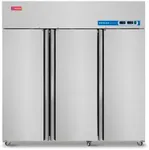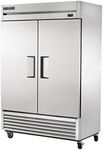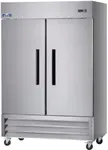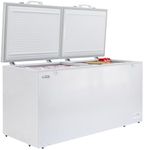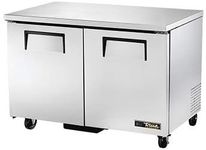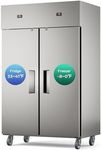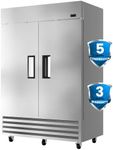Buying Guide for the Best Commercial Freezers
Choosing the right commercial freezer is crucial for any business that needs to store perishable goods. The right freezer will help maintain the quality of your products, ensure food safety, and optimize your storage space. When selecting a commercial freezer, consider the specific needs of your business, such as the type of products you need to store, the available space, and the volume of goods. Here are some key specifications to consider when choosing a commercial freezer.CapacityCapacity refers to the amount of storage space inside the freezer, usually measured in cubic feet. This is important because it determines how much product you can store at one time. Freezers with smaller capacities (under 20 cubic feet) are suitable for small businesses or those with limited space. Medium capacities (20-50 cubic feet) are ideal for medium-sized operations, while large capacities (over 50 cubic feet) are best for large businesses with high storage needs. Choose a capacity that matches your storage requirements without overcrowding the freezer.
Temperature RangeThe temperature range indicates the range of temperatures the freezer can maintain. This is crucial for ensuring that your products are stored at the correct temperature to maintain their quality and safety. Standard commercial freezers typically operate between -10°F and 0°F, which is suitable for most frozen goods. However, some products may require lower temperatures, so it's important to choose a freezer with a temperature range that meets your specific needs.
Energy EfficiencyEnergy efficiency refers to how much energy the freezer uses to maintain its temperature. This is important because it affects your operating costs and environmental impact. Energy-efficient models often have better insulation, more efficient compressors, and other features that reduce energy consumption. Look for freezers with Energy Star ratings or other energy efficiency certifications. If your business operates 24/7, investing in an energy-efficient model can lead to significant savings over time.
Type of FreezerThere are several types of commercial freezers, including upright, chest, and undercounter models. Upright freezers are similar to refrigerators and are good for businesses that need easy access to products. Chest freezers offer more storage space and are ideal for bulk storage but require more floor space. Undercounter freezers are compact and fit under countertops, making them suitable for small kitchens or areas with limited space. Choose the type that best fits your space and access needs.
Defrost SystemThe defrost system prevents ice buildup inside the freezer. There are two main types: manual defrost and automatic defrost. Manual defrost freezers require you to periodically turn off the freezer and remove the ice manually, which can be time-consuming but is often more energy-efficient. Automatic defrost freezers periodically heat the coils to melt the ice, which is more convenient but can use more energy. Consider how much time you can dedicate to maintenance when choosing between these options.
Construction and DurabilityConstruction and durability refer to the materials and build quality of the freezer. This is important because a well-built freezer will last longer and withstand the demands of a commercial environment. Look for freezers made with high-quality stainless steel or heavy-duty plastic, which are durable and easy to clean. Also, consider features like reinforced doors and heavy-duty hinges, which can extend the life of the freezer.
Additional FeaturesAdditional features can enhance the functionality and convenience of your freezer. These may include adjustable shelves, digital temperature controls, door alarms, and interior lighting. Adjustable shelves allow you to customize the storage space, digital controls provide precise temperature management, door alarms alert you if the door is left open, and interior lighting makes it easier to find items. Consider which features will be most beneficial for your business operations.


